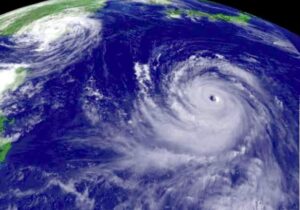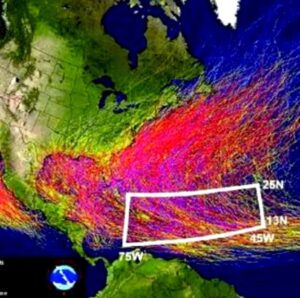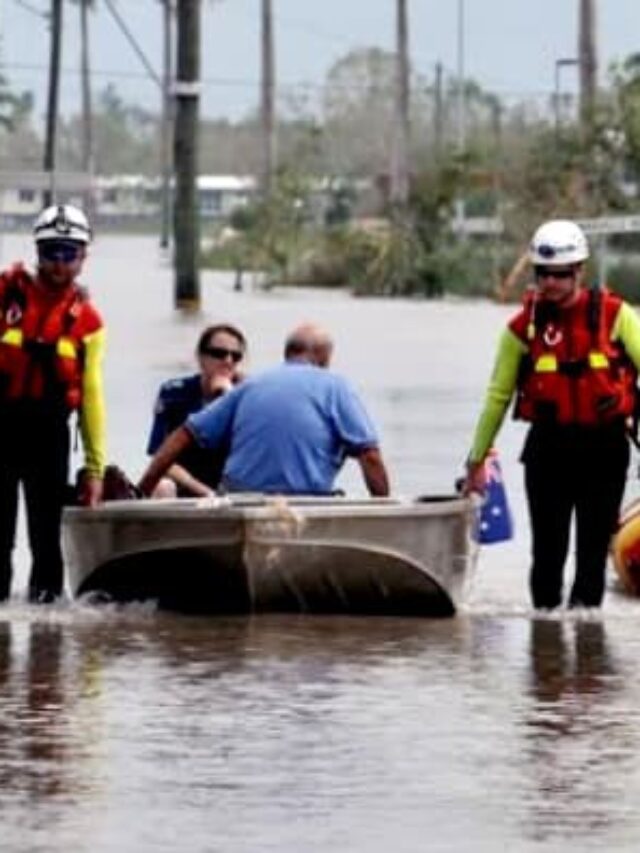“Discover the amazing impact of Tropical Cyclone Beryl, the first Category 5 hurricane in Atlantic history and this massive storm strengthened quickly.”
Posing serious hazards to the Caribbean and beyond. Stay up to date with the most recent information, wind speed predictions, and expert insights into the causes that cause such extreme weather phenomena.
Learn about how climate change is increasing the strength of tropical cyclones and the critical need for multi-hazard early warning systems to safeguard vulnerable areas.
Understand the socioeconomic consequences of such storms and the important actions being implemented to limit their effects.
Get complete information about Hurricane Beryl’s path, expected impact, and the global meteorological organizations’ coordinated efforts to provide timely and reliable forecasts.
Stay prepared and informed with extensive coverage of Tropical Cyclones Beryl.
Introduction
Tropical cyclones are among the most destructive natural occurrences, capable of transforming peaceful coastal landscapes into scenes of chaos and ruin.
Climate change is causing these violent storm systems, which are characterized by swirling winds, heavy rains, and surging seas, to become more common and severe.
The recent occurrence of Tropical Cyclone Beryl, the earliest Category 5 hurricane ever recorded in the Atlantic, highlights the storms’ rising risks.
Beryl’s quick development and destructive potential underline the critical need for a thorough understanding, readiness, and reaction strategy to limit the effects of such powerful weather occurrences.
As people throughout the world prepare for an active hurricane season, it is critical to investigate Tropical Cyclone Beryl’s genesis, track, consequences, and long-term implications for future storm management and climate resilience.
This blog post delves into the complexities of Beryl’s formation and path, the socioeconomic consequences, and the critical role of international cooperation and enhanced forecasting in protecting lives and property from the wrath of tropical storms.

Chapter 1. Understanding the Effects of Tropical Cyclone Beryl
a. Record-Breaking Formation:-
Tropical Cyclone Beryl was the first Category 5 storm ever recorded in the Atlantic. Its quick escalation from a tropical depression to a major hurricane in 42 hours set a new record.
This incredible speed exemplifies the increasing volatility of tropical storms in our changing environment.
The intensification process, fueled by extraordinarily high ocean heat content levels, underlined tropical cyclones’ powerful and frequently unexpected nature.
Such rapid expansion presents substantial challenges for forecasting and preparedness efforts, as it shortens the time available for communities to react.
Beryl’s record-breaking development is a sign of larger climatic patterns. Scientists have noticed that the frequency and strength of storms has grown in recent years.
Rising sea surface temperatures are a major contributing factor.
These warmer seas offer the energy required for storms to develop swiftly.
The Beryl instance emphasizes the necessity of continued climate research and the need for powerful forecasting techniques to better predict such disasters.
These developments have far-reaching consequences, affecting not only the immediate areas hit by the storms, but also worldwide weather patterns and ecosystems.
b. Threat to the Caribbean:-
As Beryl became more powerful, the Caribbean faced serious threats.
With maximum sustained gusts near 145 mph, the storm posed a significant threat to the communities in its path.
Countries such as Jamaica and the Cayman Islands braced for the impact, with authorities issuing warnings and preparing for evacuation.
The prospect for massive destruction prompted immediate action by governments and emergency services, emphasising the region’s susceptibility to strong hurricanes.
Infrastructure security, shelter construction, and coordination with international humanitarian organizations were among the preparations.
As the storm approached, citizens’ safety fears grew, particularly in places with less robust infrastructure.
The Caribbean, with its small island nations, is especially vulnerable to the effects of severe storms.
These nations frequently lack the capacity to effectively plan for and recover from such catastrophic occurrences.
Beryl’s threat served as a clear reminder of the importance of increased disaster planning and resilience in these regions.
Efforts to reinforce building codes, improve early warning systems, and develop comprehensive evacuation strategies are critical for reducing future disasters.
c. The Climate Change Connection
Climate change has a significant impact on the intensification of tropical cyclones.
Warmer ocean temperatures and shifting atmospheric circumstances offer a favorable atmosphere for rapid storm formation.
Beryl’s early genesis and strength highlight the critical need to address global warming and its consequences on weather patterns.
The link between climate change and storm intensity is complicated, but obvious.
As global temperatures rise, the likelihood of more frequent and severe storms grows, posing a huge risk to coastal cities around the world.
The scientific community has been vociferous about the importance of taking immediate action to reduce climate change.
Reducing greenhouse gas emissions, switching to renewable energy sources, and safeguarding natural ecosystems are critical stages in this endeavor.
The story of Beryl serves as a harsh reminder of the dangers of inaction.
It emphasizes the importance of international cooperation and the execution of measures aimed at lowering our carbon footprint.
Addressing climate change is not simply a matter of environmental stewardship, but also a critical step towards protecting human lives and livelihoods.
<script async src=”https://pagead2.googlesyndication.com/pagead/js/adsbygoogle.js?client=ca-pub-6169120380565110“
crossorigin=”anonymous”></script>
Chapter 2. Most recent updates and predictions:-
a. Wind Speed Probability
Wind speed probabilities are an important instrument for anticipating tropical cyclone impacts.
The National Hurricane Center (NHC) provides detailed visuals that show the probability of sustained winds reaching 34 knots (39 mph).
These forecasts assist communities in preparing for the approach of severe winds.
The visualizations are based on a combination of official NHC track, intensity, and wind radius projections, as well as historical error data.
This data is updated on a frequent basis to ensure the most accurate and timely forecasts.
Understanding these possibilities is critical for successful catastrophe preparedness.
Even seemingly modest probability can imply serious threats, necessitating required steps to preserve lives and property.
The NHC’s efforts to improve public knowledge of these forecasts are crucial in ensuring that people and communities take the necessary actions.
The purpose is to reduce the impact of tropical cyclones by providing clear and accessible data that can be used to drive decision-making processes at all levels.
b. Forecasts on Path and Intensity
Beryl’s expected route contained a significant threat to Jamaica, with forecasts indicating that the storm would retain hurricane strength as it neared.
The NHC’s continual updates enabled real-time monitoring and changes to preparedness plans, ensuring that residents and authorities could respond efficiently.
The precision of these forecasts is critical in reducing the damage of tropical cyclones.
They provide critical direction for evacuation orders, resource allocation, and emergency response activities.
Ocean temperatures, atmospheric pressure systems, and wind patterns all have an impact on a hurricane’s path and intensity.
Understanding these dynamics is critical for boosting forecast accuracy.
To forecast hurricane activity, the NHC uses cutting-edge technology and complex modeling approaches.
Continuous progress in these areas is critical for increasing our ability to prepare for and respond to tropical cyclones.
As our understanding of these complex systems improves, so does our ability to protect vulnerable communities from the destructive effects of severe storms.
c. Multi-hazard early warnings
The value of multi-hazard early alerts cannot be emphasized.
These systems give timely warnings for a variety of risks, including high winds, heavy rains, and storm surges.
Effective early warning methods save lives by providing communities with the information they need to take precautions ahead of time.
Integrating various hazard warnings into a single, cohesive system improves the overall efficiency and efficacy of disaster response efforts.
It guarantees that all potential hazards are communicated properly and completely.
The development and implementation of multihazard early warning systems necessitate significant investment and collaboration.
Governments, meteorological agencies, and international organizations must collaborate to develop strong frameworks that can adapt to the changing nature of climate-related hazards.
These systems’ performance is dependent on precise data collecting, advanced analytical tools, and efficient communication routes.
By prioritizing these factors, we can improve our ability to respond to tropical cyclones and other natural catastrophes, eventually reducing their impact on vulnerable populations.
Chapter 3. Socioeconomic Effects and Preparednes:-
a. Economic Effects
Tropical cyclones like Beryl have substantial socioeconomic consequences.
In 2017, Hurricane Maria destroyed Dominica, causing the country to lose 800% of its GDP.
Similar storms can derail development for years, emphasizing the importance of strong disaster risk management systems in mitigating such severe economic repercussions.
Hurricanes have an economic impact that goes beyond immediate infrastructure damage; it also affects long-term growth prospects, employment, and overall economic stability.
Rebuilding efforts following a large hurricane can put a strain on national budgets and redirect resources away from other critical services.
This has long-term implications for education, healthcare, and social services.
The economic impact of tropical cyclones highlights the need of disaster preparedness investments.
Strengthening infrastructure, improving early warning systems, and building comprehensive recovery plans are all critical measures in reducing the economic impact of such occurrences.
International cooperation and support are also critical in assisting affected countries in rebuilding and recovering more efficiently.
b. Community preparedness
Preparedness is essential for reducing the damage caused by tropical cyclones.
Communities in the path of Beryl made considerable precautions, ranging from property security to evacuation routes.
Public awareness campaigns and government assistance were critical in these endeavors.
Disaster management relies heavily on ensuring that populations are informed and prepared for potential dangers.
This includes informing the public about the risks connected with tropical cyclones and offering clear instructions on how to respond successfully.
Community-based preparedness activities can dramatically boost resilience.
Local governments, community organizations, and people must all collaborate to create and implement comprehensive disaster preparedness programs.
These plans should include safeguards for vulnerable groups, such as the elderly and those with disabilities, as well as procedures for ensuring crucial services during and after a storm.
Building healthy, resilient communities necessitates a collaborative strategy that utilizes local knowledge and resources to improve overall preparation.
c. International Cooperation
Global cooperation is critical in mitigating the effects of tropical cyclones.
The World Meteorological Organization (WMO) and other international organizations collaborate to offer accurate predictions and enhance disaster response operations.
This collaboration guarantees that countries, particularly those with low resources, get the assistance they require during crises.
In the aftermath of a disaster, international help can give crucial support, ranging from financial assistance to technical expertise and humanitarian supplies.
International collaboration depends on effective communication and coordination among all parties involved.
Sharing data, resources, and best practices can help to increase disaster response effectiveness and resilience.
Collaborative initiatives, like as the WMO’s Coordination Mechanism, are critical to supporting this cooperation.
Countries that work together can better prepare for and respond to tropical cyclones, decreasing their impact on vulnerable areas.
Chapter 4. The Role of Meteorological Organizations:-
a. Accurate Forecasting:
Tropical cyclone management relies heavily on accurate forecasting.
Meteorological institutions such as the NHC and the WMO make precise projections about storm routes, intensity, and potential repercussions.
These projections are critical for developing public safety and catastrophe response plans.
b. Support systems:
The WMO Coordination Mechanism, which is sponsored by several international meteorological agencies, is critical in delivering timely updates and guidance.
This mechanism ensures that the UN and humanitarian groups are well-informed and can work together effectively to help affected regions.
c. Future forecasts
The Intergovernmental Panel on Climate Change (IPCC) anticipates that the frequency and intensity of tropical cyclones will rise as the planet warms.
This emphasizes the need for continuous advances in predicting technology and disaster planning in order to better manage future storms.
Chapter 5. Lessons From Hurricane Beryl:
a. Rapid Intensification:-
Beryl’s quick strengthening exemplifies the unpredictable nature of tropical cyclones.
Understanding the causes that drive such rapid development is critical for strengthening early warning systems and planning for such catastrophes in the future.
b. Community resilience:-
It is critical to strengthen community resilience.
Efforts to build infrastructure, increase emergency response skills, and boost public knowledge can help to mitigate the impact of tropical cyclones.
Beryl’s impact on the Caribbean emphasizes the significance of these measurements.
c. Climate Action:
Addressing climate change is critical to mitigating the growing threat of powerful tropical cyclones.
International initiatives to minimize greenhouse gas emissions and promote sustainable practices are crucial for mitigating the long-term consequences of global warming.

Chapter 6 . More Information about Hurricane Beryl
a. Path and Impact
Hurricane Beryl posed a threat to several Caribbean nations.
The storm took a direct hit on Grenada and severely devastated St. Vincent and the Grenadines.
These little islands, which had limited experience dealing with such intense hurricanes, had significant obstacles.
The impact of Beryl underlined the need for improved disaster preparedness and resilience in these areas.
Meteorological organizations closely tracked the storm’s path, providing affected populations with regular information and guidance.
The severity of Beryl’s impact varied by region, with some areas sustaining greater damage than others.
Storm surges and excessive rainfall posed significant threats to coastal areas.
The hurricane caused significant damage to infrastructure, houses, and livelihoods.
Recovery activities necessitated tremendous resources and coordination, emphasizing the importance of effective disaster management plans.
Beryl’s experience reminds us of the need for continued investment.
Also included are the Grenadines.
These little islands, with little experience dealing with strong hurricanes, faced significant hurdles.
The aftermath of Beryl underlined the need for improved disaster preparedness and resilience in these areas.
Meteorological groups closely tracked the storm’s path and gave frequent updates and recommendations to affected populations.
The degree of Beryl’s impact varied by region, with some areas suffering more serious damage than others.
Storm surges and excessive rainfall posed special threats to coastal areas.
The storm’s aftermath caused considerable damage to infrastructure, houses, and livelihoods.
Recovery activities necessitated tremendous resources and coordination, highlighting the importance of effective disaster management systems.
Beryl’s experience serves as a reminder of the importance of continual investment in preparation and resilience to future storms.
ī

Conclusions
Tropical cyclones, like the strong Hurricane Beryl, serve as stark reminders of nature’s force and unpredictability.
Beryl’s rapid intensification and unexpected early appearance as a Category 5 hurricane have broken records and raised concerns about future storm seasons.
The significant damage wrought by Beryl, from the Caribbean to probable repercussions on the US mainland, emphasizes the crucial need of early warning systems, strong preparatory measures, and effective disaster response tactics.
As climate change continues to alter weather patterns, increasing the frequency and severity of such storms, it is critical for communities, governments, and international organizations to work together closely.
Improved forecasting technologies, extensive storm preparedness education, and robust infrastructure are critical components in reducing the deadly effects of tropical cyclones.
Beryl’s story is one of destruction, but also of resilience and human adaptability in the face of natural disasters.
We can better protect lives and livelihoods by learning from each storm and strengthening our response mechanisms on an ongoing basis.
The lessons learned from Hurricane Beryl will surely impact future efforts to protect against the expanding hazards posed by tropical cyclones, ensuring that societies remain resilient and well-prepared for the challenges ahead.
FAQ:
1. What is the definition of a tropical cyclone?
A tropical cyclone is a revolving storm system with a low-pressure center, powerful winds, and heavy rain. It occurs over warm ocean waves and can do major harm to coastal areas.
2. What is the definition of tropical storm-force winds?
Sustained surface wind speeds equal to or more than 34 knots (39 mph) are classified as tropical storm winds. These winds can wreak massive damage and pose a substantial threat to towns along the storm’s path.
3. How might early warning systems aid catastrophe preparedness?
Early warning systems give fast and reliable information about tropical cyclones’ expected paths and intensities. This allows communities to take steps and evacuate if required, lowering the risk to lives and property.
4. How does the National Hurricane Center (NHC) contribute to hurricane forecasting?
The National Hurricane Center tracks and forecasts tropical cyclones in the Atlantic and eastern North Pacific basins. It provides critical information and advice to help communities prepare for and respond to hurricanes.
5. How does climate change impact tropical cyclones?
Climate change increases the frequency and intensity of tropical cyclones by boosting ocean temperatures and changing air conditions. This leads in more strong and catastrophic storms.
6. What is the World Meteorological Organisation (WMO)?
The World Meteorological body is an intergovernmental body that organizes global efforts to monitor and respond to weather-related dangers, such as tropical cyclones. It supplies resources and assistance to meteorological authorities worldwide.
7. How may communities increase their resilience to tropical cyclones?
Communities can build resilience by increasing early warning systems, reinforcing infrastructure, and raising awareness and readiness. Involving communities in planning and decision-making processes is also critical.
8. What can we learn from Hurricane Beryl?
Hurricane Beryl emphasizes the value of continual monitoring, timely updates, and good disaster planning. Communities can build resilience to future tropical cyclones by learning from previous experiences.
9. What are the implications of wind speed probability in hurricane prediction?
Wind speed probabilities provide information on the possibility of sustained surface wind speeds in specified areas. This data aids in determining the possible impact of tropical-storm-force winds and guiding preparations for their arrival.
10. What made Tropical Cyclone Beryl significant?
Tropical cyclone Beryl was important because it was the first Category 5 hurricane ever recorded in the Atlantic. Its quick strengthening established new standards for tropical storms.
11. How did Beryl affect the Caribbean?
Beryl posed a significant threat to the Caribbean, with maximum sustained winds approaching 145 mph. Countries such as Jamaica and the Cayman Islands faced substantial threats and made extensive precautions.
12. How does climate change affect tropical cyclones?
Climate change exacerbates the severity and frequency of tropical cyclones by raising ocean temperatures and altering air conditions, promoting fast storm development.
13. How do wind speed probability influence forecasting?
Wind speed probabilities assist anticipate the possible effect of tropical cyclones by indicating the chance of sustained winds greater than 34 knots. These projections contribute to community preparation.
14. What is the socioeconomic impact of tropical cyclones?
Tropical cyclones can have serious socioeconomic consequences, delaying development for years and incurring major infrastructural damage. Effective catastrophe risk management is critical.
15. How can international cooperation help to manage tropical cyclones?
International cooperation, aided by organizations such as the WMO, ensures accurate forecasts and coordinated disaster response activities, thereby offering critical assistance to afflicted regions.
16. What lessons can we take from Hurricane Beryl?
To reduce future tropical storm risks, key lessons from Hurricane Beryl include raising knowledge about rapid intensification, developing community resilience, and tackling climate change.






“Every teacher can teach intelligent students, but the ideal teacher is the one who can make weak children intelligent.”